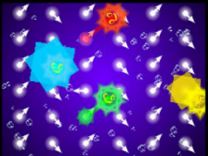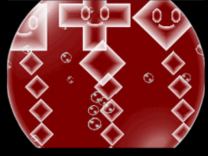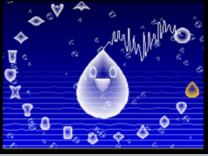Taking a completely different approach to
video games, Nintendo's Electroplankton allows gamers to play with virtual fish
and create music while watching the screen light up with mesmerizing patterns,
animations and, colors. This is a fascinating game where the player is given
complete control over their environment, allowing them to decide what types of
sounds, angles and arrows to use. The DS system's touch pad is put to good use,
and allows a unique type of interactivity to occur. Electroplankton is a unique
title that succeeds because it defies conventions, and offers players a chance
to experiment, explore and, create their own world.
There's little doubt that Nintendo's DS
handheld has enjoyed a reputation for coming up with some truly unique and
interesting games that think outside the usual structures of gaming. Many of the
titles need no introduction to the hardcore gamer, but one title that seems to
be consistently overlooked is the brilliant Electroplankton. Designed by
renowned Japanese artist Toshio Iwai, Electroplankton's concept is deceptively
simple. Released in limited quantities earlier this year, this innovative music
title hasn't received the publicity that other games on the system have, most
likely due to the fact that it's been consigned to an online-only release. This
is a real shame, because it plays both to the system's strengths without making
any compromises in terms of its approach. Perhaps, this niche title is still too
far ahead of its time, a concept that even mainstream gamers who have embraced
the console with a surprising ferocity might find a bit strange. However, those
lucky and persistent enough to own a copy of the game are in for a real treat:
this is a magical experience unlike any other on any system released to date.
The game's presentation is quite simple, with the upper screen used as a
close-in view of individual plankton, which the player can adjust angle and
viewpoint, while the touch screen acts as the interaction point for the majority
of your controls. You can choose to watch the plankton in Audience mode, but the
real appeal of the game lies in the Perrformance mode, where you can interact
with them.
 When
you perform, you use the DS stylus to control ten different species of
Electroplankton. Each type of plankton emits a different sound when touched,
which the player can control by moving the stylus, drawing shapes on the touch
screen or changing the direction they move. This affects the notes they play,
with an almost infinite number of variations. Depending on which of these
different species you select, you play the game differently. Each one gives the
player a different type of interaction and structure. There ten types in all
including Electroplankton who give off a unique sound when you spin them around,
others follow paths you draw on the screen, and there are others where you
record a brief sound sample and make them repeat it. Each type of interaction
offers a unique sound palette which range from ghostly ethereal, to piano keys,
and even computerized, almost techno sounding samples. This gives you quite a
variety of sounds to play around with, making for an almost limitless
experience. Players can also move snowflake planktons around the screen and
watch as they move around. Some of the Plankton levels are almost like games,
such as the one where players aim the small fish at leaves on a tree, or can
change the directions of arrows that they follow to make unique compositions.
Within each of these levels, players can change the presentation and layout by
hitting the select button, which resets the screen and ends the current
composition. Players can also control the rhythm, speed and beats of each level
by using the control pad, which adds further possibilities to the mix. One of
the main reasons why Electroplankton is so appealing is that it gives the player
an empty canvass in which to paint their sounds.
When
you perform, you use the DS stylus to control ten different species of
Electroplankton. Each type of plankton emits a different sound when touched,
which the player can control by moving the stylus, drawing shapes on the touch
screen or changing the direction they move. This affects the notes they play,
with an almost infinite number of variations. Depending on which of these
different species you select, you play the game differently. Each one gives the
player a different type of interaction and structure. There ten types in all
including Electroplankton who give off a unique sound when you spin them around,
others follow paths you draw on the screen, and there are others where you
record a brief sound sample and make them repeat it. Each type of interaction
offers a unique sound palette which range from ghostly ethereal, to piano keys,
and even computerized, almost techno sounding samples. This gives you quite a
variety of sounds to play around with, making for an almost limitless
experience. Players can also move snowflake planktons around the screen and
watch as they move around. Some of the Plankton levels are almost like games,
such as the one where players aim the small fish at leaves on a tree, or can
change the directions of arrows that they follow to make unique compositions.
Within each of these levels, players can change the presentation and layout by
hitting the select button, which resets the screen and ends the current
composition. Players can also control the rhythm, speed and beats of each level
by using the control pad, which adds further possibilities to the mix. One of
the main reasons why Electroplankton is so appealing is that it gives the player
an empty canvass in which to paint their sounds.
 This open-ended structure makes it almost
immediately accessible for all ages and types, and allows virtually anyone to
compose and create a unique soundscape. Electroplankton has this approach in
common with many of the timeless classic games, which is what it most closely
resembles. The game's overall look is rather simple, almost Spartan, but this
simplicity allows it to have a greater impact. It's hard to play the game and
not be reminded of some of the more timeless games ever created.
Electroplankton's open-ended approach recalls the open playfields of Asteroids,
the cute characters of Pac Man and the child-like play box feel of Nintendo's
earliest games. It's not an accident to see that many classic Nintendo sound
samples make appearances later on. This gives the game an open-ended, almost
limitless appeal that makes it an almost perfect diversion. By combining sound
with interactivity so brilliantly, Electroplankton also points out the key
element of games, ones that are frequently overlooked in a sea of licensed
tracks that serve as noisy distractions, its nice to see so much thought put
into not just the music, but the types of tones as well. While it isn't an
educational title in practice, the game also serves as a fun, accessible look at
music structure, with its lighter tones usually arranged towards the top of the
screen, with darker, deeper tones towards the bottom. The game also does an
excellent job of visualizing beats, structure and rhythms with its bright,
colorful animations with vibrate with life and beauty.
This open-ended structure makes it almost
immediately accessible for all ages and types, and allows virtually anyone to
compose and create a unique soundscape. Electroplankton has this approach in
common with many of the timeless classic games, which is what it most closely
resembles. The game's overall look is rather simple, almost Spartan, but this
simplicity allows it to have a greater impact. It's hard to play the game and
not be reminded of some of the more timeless games ever created.
Electroplankton's open-ended approach recalls the open playfields of Asteroids,
the cute characters of Pac Man and the child-like play box feel of Nintendo's
earliest games. It's not an accident to see that many classic Nintendo sound
samples make appearances later on. This gives the game an open-ended, almost
limitless appeal that makes it an almost perfect diversion. By combining sound
with interactivity so brilliantly, Electroplankton also points out the key
element of games, ones that are frequently overlooked in a sea of licensed
tracks that serve as noisy distractions, its nice to see so much thought put
into not just the music, but the types of tones as well. While it isn't an
educational title in practice, the game also serves as a fun, accessible look at
music structure, with its lighter tones usually arranged towards the top of the
screen, with darker, deeper tones towards the bottom. The game also does an
excellent job of visualizing beats, structure and rhythms with its bright,
colorful animations with vibrate with life and beauty.
 What
really makes Electroplankton appealing beyond the usual boundaries of games is
its open-ended approach, there's little if any pressure to perform or play
within any confines or rules. Instead the game allows you to play as long as you
want, an with as much or little intensity as you like. You can set up a simple
song and watch as it plays passively, or actively change the tempo, speed and
notes of as they play. How you approach the game is really up to you. Of course,
there are some modes which really burst out when you use some structure, such as
drawing concentric circles or other geometric shapes. You can watch others and
watch how small changes, such as changing the direction of a single arrow on the
screen, can make a big difference in how the song plays out. It's this sense of
being in complete control that makes Electroplankton so rewarding.
What
really makes Electroplankton appealing beyond the usual boundaries of games is
its open-ended approach, there's little if any pressure to perform or play
within any confines or rules. Instead the game allows you to play as long as you
want, an with as much or little intensity as you like. You can set up a simple
song and watch as it plays passively, or actively change the tempo, speed and
notes of as they play. How you approach the game is really up to you. Of course,
there are some modes which really burst out when you use some structure, such as
drawing concentric circles or other geometric shapes. You can watch others and
watch how small changes, such as changing the direction of a single arrow on the
screen, can make a big difference in how the song plays out. It's this sense of
being in complete control that makes Electroplankton so rewarding.
While its
basic structure is immediately understandable, those who dig deeper and go under
the surface and experiment with different approaches will be rewarded with some
really cool surprises when they play through the game. This is definitely a
title that has long term appeal, Electroplankton is enjoyable whether you want
to play for five minutes or two hours. The only major drawback to the title we
can really articulate is the inability to save your songs, which means you can't
replay your creations or send them to your friends. This is somewhat
disappointing, but it is a relatively minor inconvenience in the grand scheme of
things. Nintendo has definitely enjoyed some unique software for the DS to date,
but Electroplankton stands above many of these innovative titles in its singular
presentation and unique style. While many games these days are ratcheting up the
intensity and production values, this title has taken a completely different
approach. Electroplankton is a thoroughly unique experience which is inspiring
and therapeutic.
Grade: A

